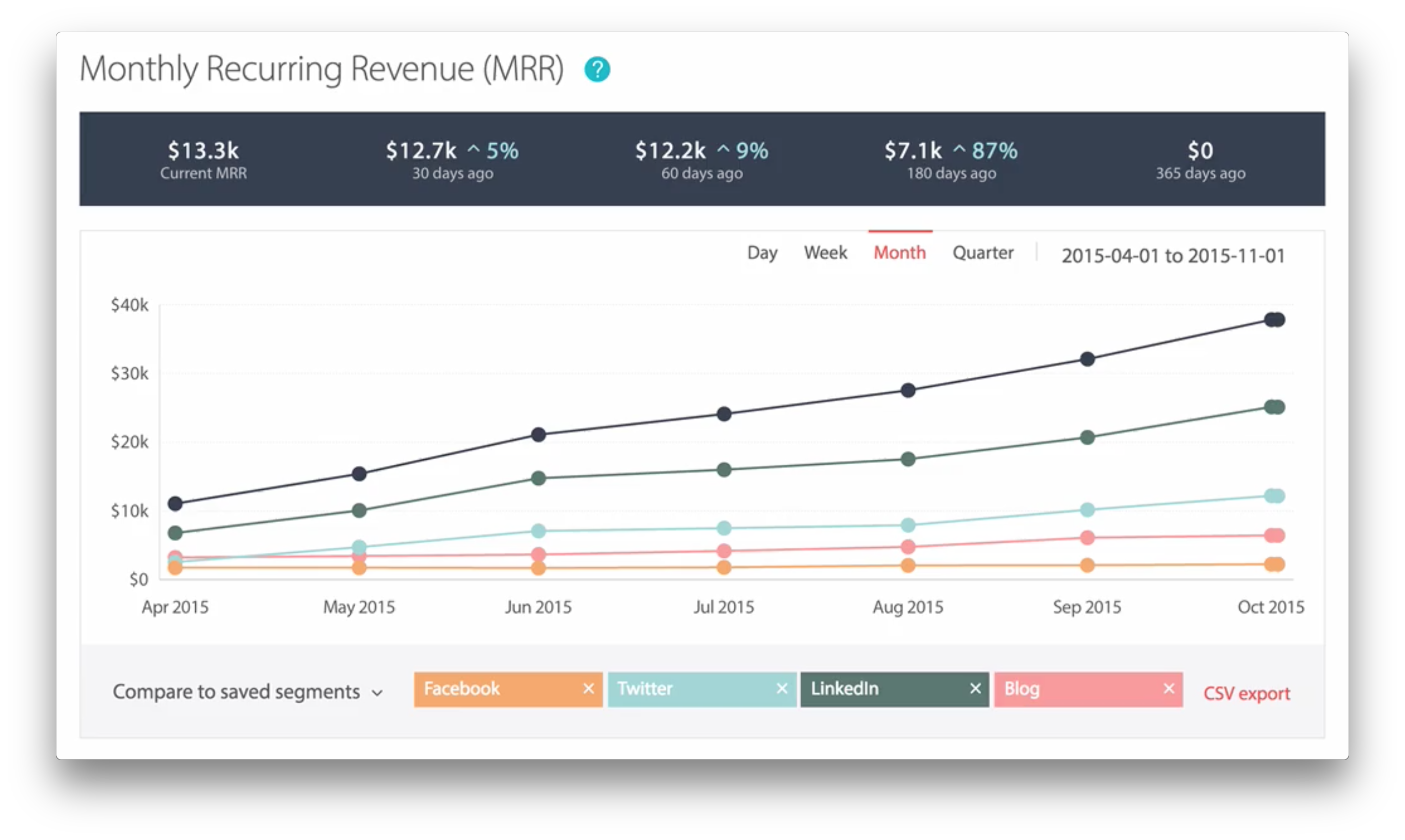There are many platforms that support advanced customer segmentation, most of which provide their own built-in segments which act as a suitable starting point. To really get the most from such a tool though, you’ll want to create your own custom segments, based on as the most relevant data available for your customers.
With segmentation employed in the right way, you can answer the following questions and much more:
- Which types of customer are most profitable for me?
- Which marketing channels produce the highest value customers?
- How can I better understand where my customers are losing their way in my onboarding process?
- Which 20% of customers are using 80% of my customer support resources?
When is segmentation not suitable?
One question you shoud consider is “Do I have enough data for the segments I use to be representable?”. If you have just a handful of customers, the answer is most likely a “no”. In which case, you’d be better off employing other methods for measuring your customers. If you are not able to fulfil one or more of the points below, you should reconsider implementing customer segments:
What makes a useful customer segment?
You really can’t go too far with using different data for segmentation. The more information you have on how your customers are behaving in your product, the higher level of fine-grained detail you can use in defining different groups. As Tomasz Tunguz suggests, your segments should be measurable, addressable, stable and consistent in order to be used effectively. But what does that really mean?
- Measurable – You can assess its value, through some form of metric, and that you have enough data to produce that metric.
- Addressable – You can have a real impact on the segment of customers you’re identifying (otherwise why would you define the segment?).
- Stable – Segments need to have minimal fluctuation caused by external factors. Such instability will mean that you’re unable to pull any reliable insights from the segment.
- Consistent – You measure the segment in the same way, across its lifetime. Changing the way you measure it would effectively nullify the value of any findings.
Choosing the right tool for segmentation
With a wealth of analytics tools offering some form of segmentation in the market, you should make sure you’re picking a solution that can offer the range of functionality you need.
When we approached adding a set of advanced segmentation features to ChartMogul, we considered each of the points below as critical to the success of the release of a flexible, open tool that can be useful to almost any business, regardless of the platform on which their data exists.
Note: If you didn’t see the recent announcement, ChartMogul now supports the enrichment of customer profiles through API (or even automatically through our Clearbit integration) along with the ability to define and use custom segments within the ChartMogul dashboard. Read more here:
Which data sources do you want to use? Does the platform provide an integration for these?
You’ll likely want to leverage a wide range of data from multiple sources, e.g. paid marketing data from Twitter, sales data from Close.io or another CRM tool, industry data from another source – the possibilities are endless. You should make sure that you can get this data into your segmentation platform of choice. This would usually be through one of the following features:
- An integration with the platform. This method would usually be lowest-effort for your team.
- A public API. You’ll need to dedicate some development resources to integrate the API, but once setup you’ll have a fully-automated connection.
- Manually importing the data. This is usually done by uploading a file containing data in a specific format, such as CSV or XML. This method will likely require the most effort, as you’ll need to get your data in the correct format, and spend some time importing each time you want to update the data.
How flexible is the tool – can you define the segments you need?
Analytics platforms vary when it comes to defining customer segments. Whilst some might offer a fairly rigid rule-based system, some of the more advanced platforms allow you to define almost any combination of parameters and rules, sometimes even with nested rules or conditional statements. It’s definitely worth mapping out which customer segments are important to your business, and how you would actually define those first.
Example segment:
“Customers acquired through Twitter campaigns that have an active trial.”
Example rules:
Acquisition channel = “twitter_paid”
AND account_status = “active_trial”.
How is the data visualized? Can you compare multiple segments and get the insights you really need?
You should take some time to look at how segmentation fits into the features of the platform. Which KPIs can you segment, and how is the data represented? If you want to see your LTV broken down per segment for example, make sure you can apply a segment filter to the LTV metric.

Food For Thought: Interesting Customer Segments
Signed up but not fully onboarded
You should make it your mission to talk to and find out more about these customers – they hold the key to unlocking a smoother onboarding process for your product. Why did they drop off the onboarding flow? Did something confuse them? Or did they simply find out that your product wasn’t quite what they felt they were promised in the first place?
All of these answers mean you need to make changes in some way, whether in your marketing/customer acquisition strategy, or in product improvements – particularly in the design of your onboarding process.
Defining this segment: You’ll need to integrate some form of measurement into your product’s onboarding flow to achieve this, and to flag each customer’s progress through it.
At-risk of churn
Warning!! These customers are wobbling on the edge of churn. Focus your Customer Success efforts here to bring them back from this cliff of no-return. Make it your personal mission to review this list every day and to do whatever it takes to minimize churn from these customers. Or if you can’t do that, talk to them and understand why they have become disengaged with your product.
Defining this segment: The definition of “churn-risk” customers is fairly fuzzy, and is often defined in different ways across different products. You’ll need to think about what measurable factors would highlight customers that are disengaged with your product. It would probably be highly focused around how active the customer is.
Low value / high maintenance / unprofitable customers
Let’s be realistic here; these customers are dragging you and your business down. They squeeze you for every possible discount in order to buy in the first place, and when they’re finally subscribed they generate so many support requests, they’re probably cashflow-negative for your business. So what to do with them? Some ideas:
- Charge them for support
- Limit their support entitlement
- Let them go(!) – No really. It’s okay to do this.
Defining this segment: This will require you to have access to support tickets and plans belonging to the customer in the system you’re using. You’ll obviously need to decide what is a reasonable threshold at which a customer becomes “high maintenance”. Perhaps start by looking at the bottom 10% of your customers, in terms of profitability?
Advocates
These customers are the ones using your product to its fullest. And to top it off, they’re also the most vocal about using it and sharing their experience. They’ll give you highly valuable feedback, refer other new customers and are probably more than happy to give you a case study or quote for your website. Here are some actions you’d want to take with this segment:
- Understand their needs and goals – look-a-likes of this customer should be your number one target for new business, as they’ll likely use it (and love it) in the same way.
- Take their feedback and feature requests on board, especially negative feedback. You should probably fix the things that are causing them any pain.
- Use them – and their shining comments – for case studies, customer stories, quotes, and other content marketing. Their words will carry the most weight when potential customers are evaluating your product.
Defining this segment: Look for a combination of high engagement with the product (on a wide range of features) and high NPS score.
In summary
Deep segmentation can definitely take your understanding of the spread of your customer base to the next level. And whilst it’s not always easy to set up and make the data available, the effort is likely to pay off in the long run, when you can make key decisions about the growth of your business, with the backup of solid, actionable data.

